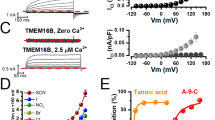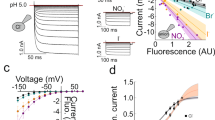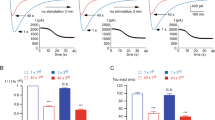Abstract
Nerve cells can maintain a very low intracellular calcium concentration ([Ca2+]i) against large Ca2+ electrochemical gradients (see ref. 1 for review). The properties of the calcium efflux from these cells depend on [Ca2+]i (ref. 2), and within the physiological range, most Ca efflux depends on ATP (which stimulates with high affinity) and is insensitive to Nai, Na0 and Ca0 (uncoupled Ca efflux). When the [Ca2+]i is well above the physiological range, Ca efflux becomes only partially dependent on ATP (acting now with low affinity), is inhibited by Nai and is stimulated by Na0 and Ca0 (Na–Ca exchange). Orthovanadate, a powerful inhibitor of the (Na++K+) ATPase and the Na pump3,4, also inhibits the Ca-stimulated ATPase activity, which is the enzymatic basis for the uncoupled Ca pump, in human red cells5. The experiments reported here show that in squid axons the ATP-dependent uncoupled Ca efflux can be fully and reversibly inhibited by vanadate, whereas concentrations of vanadate 10 times higher have no effect on the Na–Ca exchange. This is another indication that the uncoupled Ca efflux represents an ATP-driven Ca pump, and supports the suggestion that the uncoupled Ca efflux and Na–Ca exchange are mediated by different mechanisms2.
This is a preview of subscription content, access via your institution
Access options
Subscribe to this journal
Receive 51 print issues and online access
$199.00 per year
only $3.90 per issue
Buy this article
- Purchase on Springer Link
- Instant access to full article PDF
Prices may be subject to local taxes which are calculated during checkout
Similar content being viewed by others
References
Baker, P. F. Prog. Biophys. molec. Biol. 24, 177–223 (1972).
DiPolo, R. & Beaugé, L. A. Nature 278, 271–273 (1979).
Beaugé, L. A. & Glynn, I. M. Nature 268, 355–356 (1977).
Cantley, L. C. et al. J. biol. Chem. 252, 7421–7422 (1977).
Bond, G. H. & Hudgins, P. M. Fedn. Proc. 37, 315 Abstr. (1978).
Brinley, F. J. & Mullins, L. J. J. gen. Physiol. 52, 181–211 (1968).
Lew, V. L. Nature 274, 421–422 (1978).
Beaugé, L. A. & DiPolo, R. Biochim. biophys. Acta 551, 220–223 (1979).
Beaugé, L. A. in 2nd Conf. on Properties and Functions of Na, K-ATPase (ed. Skou, J. C.) (Academic, New York, in the press).
Beaugé, L. A. & Glynn, I. M. Nature 272, 551–552 (1978).
Author information
Authors and Affiliations
Rights and permissions
About this article
Cite this article
DiPolo, R., Rojas, H. & Beaugé, L. Vanadate inhibits uncoupled Ca efflux but not Na–Ca exchange in squid axons. Nature 281, 228–229 (1979). https://doi.org/10.1038/281228a0
Received:
Accepted:
Published:
Issue Date:
DOI: https://doi.org/10.1038/281228a0
This article is cited by
-
A Basic Study on the Biological Monitoring for Vanadium—Effects of Vanadium on Vero Cells and the Evaluation of Intracellular Vanadium Contents
Biological Trace Element Research (2011)
-
In the squid axon Na+/Ca2+ exchanger the state of the Cai-regulatory site influences the affinities of the intra- and extracellular transport sites for Na+ and Ca2+
Pflügers Archiv - European Journal of Physiology (2008)
-
Cooling-induced supersensitivity to acetylcholine in the isolated airway smooth muscle of the rat
Naunyn-Schmiedeberg's Archives of Pharmacology (1985)
-
Modulation of apical Na permeability of the toad urinary bladder by intracellular Na, Ca, and H
The Journal of Membrane Biology (1985)
-
Vanadate and ouabain: a comparative study in toad skin
Pfl�gers Archiv European Journal of Physiology (1984)
Comments
By submitting a comment you agree to abide by our Terms and Community Guidelines. If you find something abusive or that does not comply with our terms or guidelines please flag it as inappropriate.



